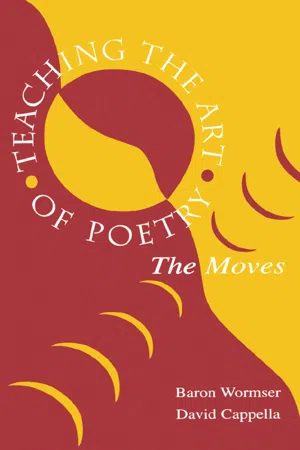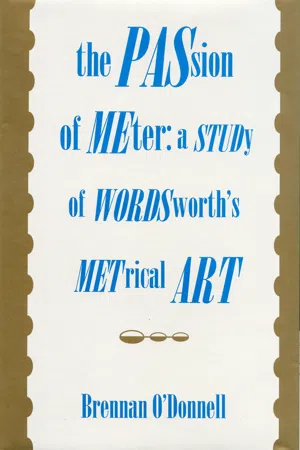Literature
Stanza
A stanza is a group of lines in a poem that form a unit within the larger structure of the poem. It is often separated from other stanzas by a space and typically has a consistent number of lines and a specific rhyme scheme or meter. Stanzas help to organize the content of a poem and contribute to its overall rhythm and meaning.
Written by Perlego with AI-assistance
4 Key excerpts on "Stanza"
- eBook - ePub
Teaching the Art of Poetry
The Moves
- Baron Wormser, A. David Cappella(Authors)
- 1999(Publication Date)
- Routledge(Publisher)
10Architecture (Stanzas)
Summary
The lines of a poem and the spaces between lines constitute a poem’s architecture. They form units that in turn form a whole. Sometimes a poem is written out all-of-a-piece without any spaces between lines. Many poems, however, use Stanzas. Stanzas come in various lengths; sometimes a poem will maintain a constant Stanza unit such as a quatrain throughout the entire poem and sometimes the Stanza lengths will vary. It depends on the artistic aims of the poet for that poem, as different sorts of Stanzas offer different possibilities. A couplet, for instance, doesn’t offer the poet the room in which to maneuver that a ten-line Stanza offers. In all cases, however, the Stanza is a great organizer, focuser, and sequencer. Stanzas help to articulate the overall energy of the poem. The spaces between Stanzas are as critical as the units themselves.Poets use all sorts of words to describe how they make a poem. Often they speak of poetry in ways that recall the title of this chapter: they “construct,” they “build,” they “carpenter.” Some poets use sculptural words; they “shape” the poem, they “form” it. Still others use kinetic words; for them the poem is a dance or a walk through a field or a crawl over uncertain terrain. Whatever analogy the poet prefers, a sense of how the poem hangs together is common to all of them. Poems are mysterious creations whose origins lie in the rich vagaries of inspiration, but they are, nonetheless, coherent creations. A poem’s lines relate to one another; they echo and interpenetrate and angle as they form “an intellectual and emotional complex.” Donald Hall has written that the poem is multi-faceted. It is like a diamond. Every syllable and every word is a facet and there are relationships of sound and meaning among all the syllables and words. Mathematically this means that even a “tiny” poem generates thousands of facets. Light bounces off them in ever-unpredictable ways. - eBook - ePub
- Jeffrey Wainwright(Author)
- 2015(Publication Date)
- Routledge(Publisher)
7 StanzaLet me hear a staff, a stanze, a verse.(Shakespeare, Love’s Labour’s Lost , Act IV Sc. 2)When the comic character Holofernes makes this demand he is either showing off by using three words where one will do, or he is uncertain which word to use. He wants Nathaniel to read him some poetry and in the 1590s the word Stanza , to refer to a grouping of lines, was quite new in English. But, with the sixteenth century’s attraction to Italian models, it was coming to displace the Old English word staff . The French word verse , then as now, could refer to a group of lines, a single line, or simply mean poetry in the generic sense.After Nathaniel has read a dozen or so lines Holofernes interrupts him complaining ‘You find not the apostrophus, and so miss the accent’, in other words he is missing the correct places to pause. As we have seen, timing is essential to all aspects of the rhythm of poetry both for its sense and effects, so the ‘apostrophus’ – the pause – is vital.Definitions
The original sense of Stanza in Italian is ‘stopping-place’, a place to take a stand, and more particularly ‘room’. These associated senses are exactly appropriate to the established sense of Stanza in poetry. A poem in Stanzas is one comprising a series of groups of lines shaped in the same way, and usually, although not always of the same length. As each group ends, the poem has a momentary stopping-place. The structure of each Stanza itself provides a space for the words to work, for what, in his overblown way, Holofernes calls ‘the elegancy, facility and golden cadence of poetry’.For the American poet Kenneth Koch (1925–2002) a Stanza is ‘nothing more than organizing other forms of poetic music – rhythm and rhyme’ (Making Our Own Days - eBook - ePub
The Passion of Meter
A Study of Wordsworth's Metrical Art
- Brennan O'Donnell(Author)
- 2011(Publication Date)
- The Kent State University Press(Publisher)
Lyrical Ballads suggests that the prosody of the poems in “ballad Stanzas” may fruitfully be considered part and parcel of his expressed aim to illuminate the indwelling potential of whatever is most common and most familiar.StanzaIC NARRATIVES: “RUTH,”“HART-LEAP WELL,” AND “THE IDIOT BOY”Longer narrative poems in Lyrical Ballads—“Ruth,” “Hart-Leap Well,” and “The Idiot Boy,” for example—also employ metrical means in ways that make attention to the “fitting of language to metrical arrangement” an important part of the experience of reading. In such poems, as in “The Thorn” or “Ellen Irwin,” verse forms are employed that are distinguished—whether by Stanza length and complexity, length of verse, or association with historical usage—from simpler, more stylistically transparent possibilities.In “Ruth,” Wordsworth achieves considerable rhythmic and sonic complexity through the use of a six-line tail-rhyme Stanza: aa4 b3 cc4 b3 . This Stanza, which has obvious structural similarities to the ballad Stanza (it might be described as an a4 b3 C4 b3 Stanza with doubled first and third lines), had had by Wordsworth’s time a considerably more various history of use than had the ballad Stanza itself. Used both for lyrics and for narratives in Middle English, its strongest early associations are with metrical romances.36 Chaucer’s use of the Stanza in Sir Thopas helped to establish a tradition of use for parodic, comic, or light verse (Gray’s “Ode on the Death of a Favorite Cat,” for example). In the later eighteenth century, the Stanza had become increasingly popular as a serious lyric form (see Smart’s “Song to David,” Akenside’s Odes [1.1, 1.5., 1.7, et al.], and Collins’s “Ode to Pity,” for example). Frequent use of the Stanza in eighteenth-century translations and imitations of Horace’s odes suggests that the alternation of pairs of longer lines with individual shorter lines was felt to be imitative of the similar alternation of longer and shorter verses in Horace’s sapphic and adonic strophe. That Wordsworth understood the potential virtues of the Stanza as a lyric form is documented by his own use of it in “Septimi Gades,” an early adaptation of Horace, Odes, 2.6. The Stanza also is used in Lyrical Ballads, in “Three years she grew in sun and shower” and “The Waterfall and the Eglantine” (ll.51–56), as well as in eleven other lyric poems in the Poetical Works (including “Louisa” [pub. 1807], “September 1819” [pub. 1820], and “The Wishing Gate” [pub. 1828]).37 - eBook - ePub
- Stephen Matterson, Darryl Jones(Authors)
- 2011(Publication Date)
- Bloomsbury Academic(Publisher)
Paradise Lost :Of man’s first disobedience, and the fruitcan be divided up as follows:Of that forbidden tree, whose mortal taste33Of man’s / first dis / obed / ience and / the fruit Of that / forbid / den tree / whose mor / tal tasteNote here that the division into feet does not necessarily respect the integrity of individual words but rather of morphemes – units of sound – or syllables. This line, subdivisible into five metrical feet, is the pentameter (from the Greek ‘penta’ + ‘meter’, ‘a measure of five’). Note also that both these lines contain a caesura, a break or pause in the line, usually at or near its centre:Of man’s first disobedience // and the fruit Of that forbidden tree, // whose mortal tasteThese lines also use enjambment , the running-on of a poetic unit of signification from one line to the next: ‘and the fruit / Of that forbidden tree’ is one phrase, and thus the lines might be divided into three phrases, roughly consistent with breath-pauses: ‘Of man’s first disobedience / and the fruit Of that forbidden tree / whose mortal taste’.Metrics is the specific study of poetic metre; scansion the annotation of metre. Metre is usually annotated by dividing the metrical feet into ‘stressed’ (given the symbol ′) or ‘unstressed’ (∪) syllables depending on the weight given by the voice in pronunciation. The iambic metre – an unstressed syllable followed by a stressed one (∪), was, until the twentieth century, by far the dominant one in English poetry: the dominant metre (albeit with frequent deviations) of Chaucer’s Canterbury Tales , Shakespeare’s plays and sonnets, the poetry of John Dryden and Alexander Pope, of Wordsworth’s The Prelude , Coleridge’s The Rime of the Ancient Mariner
Index pages curate the most relevant extracts from our library of academic textbooks. They’ve been created using an in-house natural language model (NLM), each adding context and meaning to key research topics.
Explore more topic indexes
Explore more topic indexes
1 of 6
Explore more topic indexes
1 of 4



